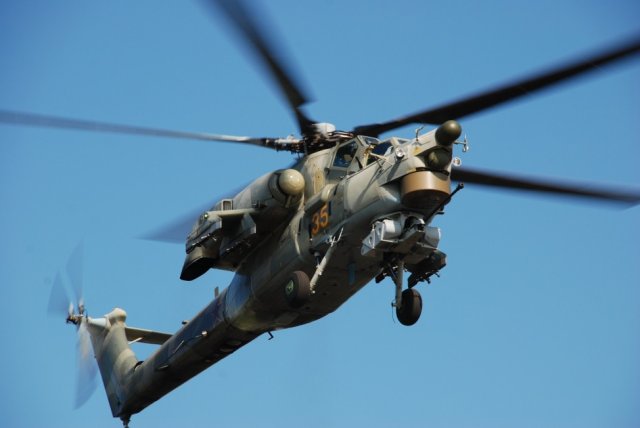Breaking news
KRET starts testing new multispectral vision system for combat helicopters.
| 2017
| a | |||
|
|
|||
|
World Defense & Security Industry News - KRET
|
|||
|
|
|||
|
KRET starts testing new multispectral vision system for combat helicopters
|
|||
|
The Radio-Electronic Technologies Corporation (KRET, a subsidiary of Rostec) started the ground testing of basic components of a multispectral synthetic vision system designed for combat and commercial aircraft. The system will boost flight safety and expand the operating envelope of helicopters, according to KRET’s press office.
|
|||
|
|
|||
 KRET's multispectral synthetic vision system is designed for combat and commercial rotorcraft KRET's multispectral synthetic vision system is designed for combat and commercial rotorcraft(Credit: Russian Helicopters) |
|||
|
|
|||
|
"At present, we are developing mock-ups of the system’s basic components and software and conducting their ground tests," says Vladimir Mikheyev, advisor to KRET’s deputy director general. "The results of the work may be applied to commercial helicopters after their adaptation to economic standards."
The multispectral synthetic vision system generates an integrated information environment in terms of tactical situation and background by using an increased number of different-waveband video sensors, pooling their data and using virtual models of terrain. The system will ramp up the pilot’s day/night all-weather vision of external environment, including the situation on the ground, for the sake of safe ground-hugging flying, takeoff from and landing on austere helipads, formation flying, search for objects of interest and self-contained navigation using optical reference points. The State Ryazan Instrument Plant (GRPZ, a subsidiary of KRET) has been refining the Okhotnik intellectual imagery processing system family for combat aircraft and air defense systems since the Soviet times. The systems are designed for gleaning as much information as possible from TV and thermal-imaging sensors. For this purpose, imagery is processed in real time using special algorithms and software to improve its quality, electronic stabilization, automatic target acquisition, autotracking and guidance. Okhotnik-family devices are the prototype of multispectral synthetic vision systems - a principal line of work of GRPZ’s designers. The devices operating in different wavebands (optical, infrared, ultraviolet, laser, radio), based on different physical principles (video sensors, IR and UV direction-finders, lidars, radars) and united in a single image easily seen by humans and maximizing the information value (Fusion technology) expand the limits of round-the-clock and all-weather vision and increase the precision and promptness of the crew’s response to the fluid situation. Developing enhanced vision systems (EVS technology), generating virtual terrain models using digital maps (Synthetic Vision Systems - SVS - technology) and combining them (Combined Vision Systems - CVS - technology) are a key line of the developing of avionics designed to equip up-to-date combat and commercial aircraft, pursued by several foreign heavyweights - Cassidian (EADS Defence&Security), Sensors Unlimited Inc. and Goodrich, Esterline CMC Electronics (Canada) Thales (France), SAAB (Sweden), Kollsman (Sweden), Texas Instruments (US) and Selex Galileo (UK) corporations, etc. In Russia, one of the organizations developing multispectral synthetic vision systems and implementing the above technologies is KRET. The advanced technologies have much improved the crew’s vision of external environment by day and at night in fine and foul weather and, thus, improved their situational awareness. The battlefield application of multispectral synthetic vision systems is due to the need for the crew to grasp the situation quickly and to the feasibility of automatic target acquisition and operation in the face of adverse weather conditions and enemy countermeasures. As the systems evolve and become cheaper, their components may be installed in commercial aircraft, in which case they ramp up flight safety radically, in particular at poorly lit airfields claiming the bulk of commercial aircraft incidents on takeoff or landing. The system that KRET is developing will become an advanced solution of the kind for helicopters, if it hits the commercial aircraft market. |
|||
|
|
|||
|
© Copyright 2015 TASS. All rights reserved. This material may not be published, broadcast, rewritten or redistributed.
|
|||



















